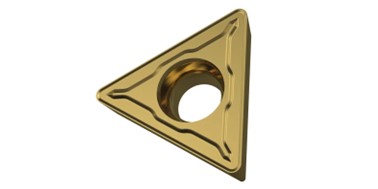
A coated cutting tool insert
Wet blasting is highly effective at preparing surfaces for all sorts of different coatings. We explain why wet blasting (or vapor blasting to give it its other name) is so effective further down the page, but to start with, we answer the question; why is it so important to thoroughly prepare surfaces for coating? Answer:
Adhesion: Proper surface preparation ensures strong adhesion between the coating and the substrate. Coatings are designed to adhere to specific surfaces, and without adequate preparation, the bond can be weak or prone to failure. Surface contaminants, such as dirt, grease, oils, rust, or loose particles, can create barriers that hinder adhesion. By thoroughly cleaning and preparing the surface, these contaminants are removed, allowing the coating to adhere effectively.
Durability: A well-prepared surface promotes the longevity and durability of the coating. When a surface is properly cleaned and prepared, it creates a clean and uniform substrate for the coating to bond to. This helps prevent the coating from delaminating, blistering, or peeling over time. The adhesion achieved through surface preparation ensures that the coating can withstand environmental factors, such as moisture, temperature changes, UV radiation, chemical exposure, and physical wear.
Smooth and even finish: Surface preparation helps create a smooth and even surface, which is essential for achieving a high-quality finish. Irregularities on the substrate, such as excessive roughness, scratches, or imperfections, can affect the appearance and performance of the coating. By properly preparing the surface, these imperfections can be minimised or eliminated, resulting in a more aesthetically pleasing and professional-looking coating.
Coating Performance: Surface preparation can directly impact the performance characteristics of the coating. For example, in industrial applications, such as automotive or aerospace coatings, surface preparation can affect the corrosion resistance, impact resistance, chemical resistance, and overall performance of the coating system. By preparing the surface, the desired performance properties can be achieved, ensuring that the coating effectively protects the substrate.
Cost-Effectiveness: Proper surface preparation can help reduce costs in the long run. By preparing the surface correctly, premature coating failures can be avoided along with the need for rework, or complete coating removal and reapplication. Surface preparation is less expensive compared to the cost of coating failure, which may require extensive repairs, replacements, or additional maintenance.
In summary, surface preparation is crucial for achieving strong adhesion, enhancing coating durability, ensuring a smooth and even finish, improving coating performance, and reducing long-term costs. It is a critical step in the coating process that significantly influences the overall quality and performance of the coated surface.

Coated rounds shank tools, powder coating metal components, spray painting additive manufactured parts
The benefits of preparing surfaces by wet blasting: Wet blasting (or vapor blasting) offers several benefits when it comes to preparing surfaces for coating applications. Some of the key advantages include:
Efficient cleaning and surface preparation: Wet blasting effectively removes various contaminants from the surface, including rust, scale, oil, grease, old coatings, and dirt. The high-pressure water and abrasive mixture can penetrate into intricate shapes and crevices, ensuring thorough cleaning and preparation of the component's surface.
Controlled surface profile: Wet blasting creates a controlled surface profile by selectively removing the material from the surface. The abrasive particles impact the surface, removing any inconsistencies, corrosion, or irregularities. This results in a textured surface that promotes better adhesion of the coating.
Non-damaging to the substrate: Unlike some other aggressive surface preparation methods like dry blasting with sand or grit, wet blasting is a gentler process. The water acts as a cushioning agent, reducing the impact force on the substrate. This makes wet blasting suitable for delicate components or substrates that can be damaged by harsher methods.
Reduced dust and airborne particles: Wet blasting significantly reduces the generation of dust and airborne particles compared to dry blasting techniques. The water suppresses dust and captures the spent abrasive and debris, preventing it from becoming airborne and minimising the risk of inhalation, contamination in the surrounding environment and explosion.
Environmental friendliness: Wet blasting is a more environmentally friendly option compared to other surface preparation methods. The use of water helps to reduce the amount of waste generated, as the spent abrasive and contaminants are collected and can be separated for proper disposal or recycling. Additionally, the absence of harmful chemicals or solvents in the process makes it a safer choice.
Versatility: Wet blasting can be performed on a wide range of materials, including metals, composites, and more. It is suitable for various components and surfaces, such as tooling, automotive components, additive manufactured parts, medical equipment, and aerospace components.
Improved coating adhesion: By effectively cleaning and creating a textured surface, wet blasting enhances the adhesion of coatings. The roughened surface allows the coating material to anchor itself better, resulting in improved bond strength and durability of the coating system.
Overall, wet blasting is a versatile and effective method for preparing components for coating applications, offering efficient cleaning, controlled surface profiling, and improved coating adhesion while minimising damage to the substrate and environmental impact.
And the benefits of wet blasting continue after the coating has been applied. Wet blasting can remove coating imperfections and peen the coating surface for increased durability.